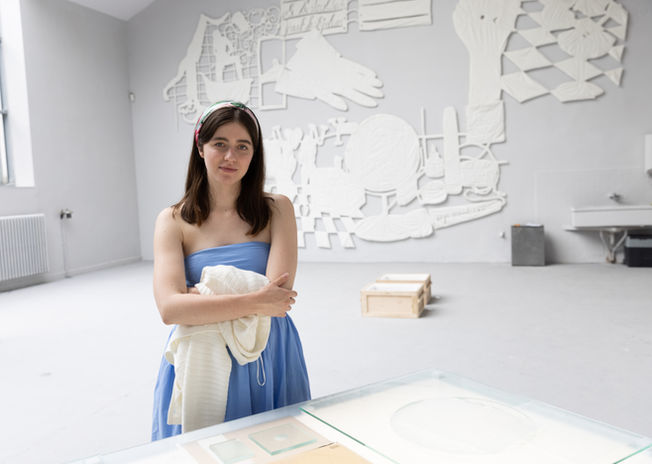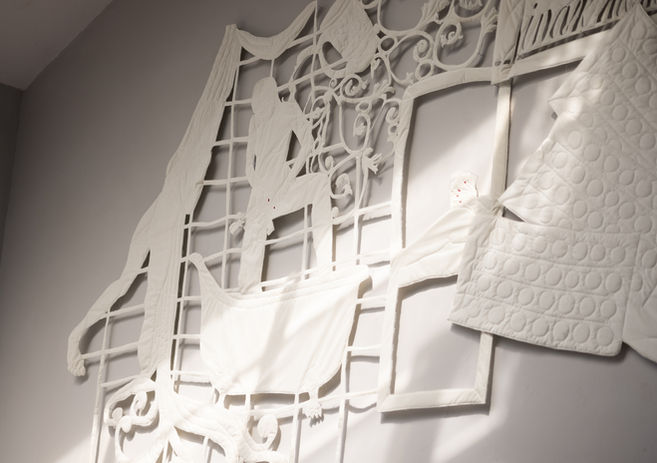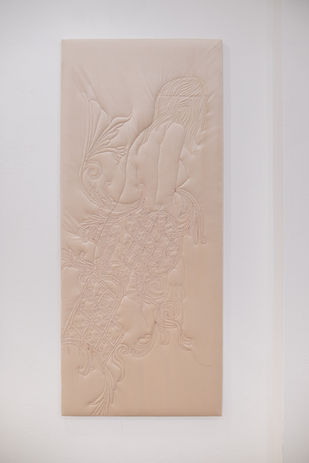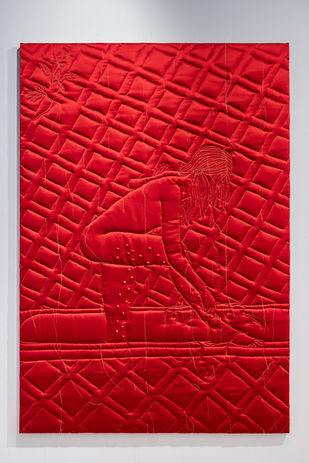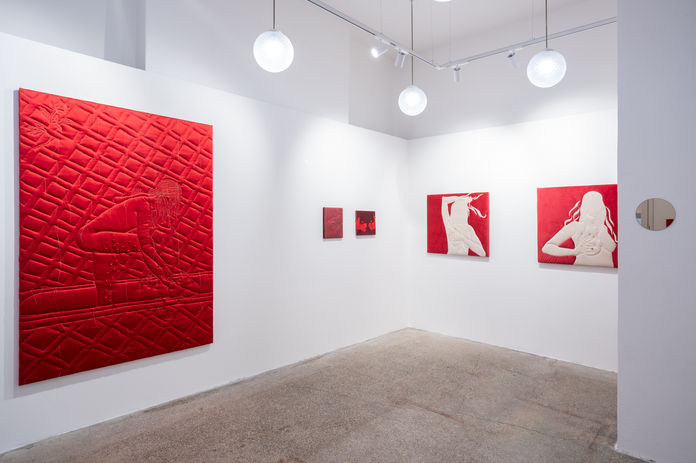SELECTED
EXHIBITIONS
AVU diploma exhibition
MIRROR, MIRROR ON THE WALL
"Mirror, Mirror on the Wall, Who’s the Fairest of Them All?" The phrase from the tale of Snow White inspired the title of Lucie Rosická’s work. Just like the wicked queen constantly checking her beauty in a magical mirror.
Rosická’s work delves into themes of beauty, observation, the pervasive use of smartphones and social media for validation. These themes have influenced her shift towards self-portraits as a natural way to express her thoughts. Her work is also deeply personal, influenced by her past struggles with eating disorders and her brief career as a model. For Rosická, the naked body in her art is not about eroticism but about communication. She views the nude figure as a blank canvas, free from the constraints that clothing imposes.
During her artistic journey, Rosická initially intended to continue her previous work of quilted paintings stretched on frames. However, several factors, including consultations with her advisors and a residency in Karlovy Vary, led her to explore new techniques. In Karlovy Vary, she experimented with "petrifying" her quilted works in mineral-rich thermal waters, creating unique, stone-like textures that echoed the town's kitschy souvenirs.
Rosická also ventured beyond traditional canvases, creating a massive work that spans an entire studio wall, measuring approximately 9 by 6 meters. This piece documents her life over the past six months, capturing personal and intimate moments. The work, composed of smaller segments, presents a diary-like narrative with monochromatic, often nude figures. It reflects on body image, care, and presentation, and touches on themes like sexuality, sexting, and pregnancy.
Accompanying this large installation are works created during her residency in Karlovy Vary. A notable piece is a small, petrified artwork depicting a face obscured by a phone, symbolizing the eternal gaze of digital validation.
Rosická’s approach combines velvet and batting layers, which she stitches together and enhances with pastels, expired cosmetics, airbrushing, and gel nail polish. Her work bridges the gap between painting and textile art, influenced by Czech textile traditions and contemporary fashion trends.
In "MIRROR, MIRROR ON THE WALL," Lucie Rosická crafts a deeply personal and reflective body of work that challenges societal norms and explores the profound impact of technology on our lives.
Foto © AVU / Radek Dětinský
THE MIRROR DIARY
- solo show Platforma 15, Prague (5. - 30.11. 2024)
cz
Název první samostatné výstavy Lucie Rosické (1998) po absolutoriu na AVU volně odkazuje ke stejnojmenné knize Garretta Honga, v níž právě zrcadlo slouží jako prostředník k sebepoznávání s přesahem do celospolečenské reflexe. Její vyšívané obrazy nesou dlouhodobě autobiografický akcent, takže je o nich reálně možné uvažovat jako o svého druhu vizuálním deníku. Nejde jen o to, že jimi otevřeně tematizuje více či méně skryté okolnosti svého života, ale i o fakt, že jejich hlavním námětem je od počátku téměř výhradně její vlastní tělo. To i dnes v její tvorbě spolehlivě slouží jako reference osobního času a životní situace, ale s tímto projektem se zřetelně mění jak perspektiva jeho zobrazování, tak informace, které nese. Dříve typický mobil a selfie-pózy nahradil pátravý pohled do zrcadla. Také koupelna - jindy dráždivá scéna pro vzrušující snímky nebo místo intimní péče - se transformovala v oázu klidu a času pro sebe. Katalyzátorem toho všeho se stalo mateřství. A právě proměny, které odstartovalo, se staly leitmotivem výstavy. Lucie Rosická skrze sebe vždy pojmenovávala témata rezonující v širším generačním kontextu, ať už to byly tlak na sebeprezentaci, partnerské odloučení nebo otázky sebepřijetí. Ostatně právě tady má zřejmě základ i její oblíbený princip, kdy nedokonalá místa na těle začala zvýrazňovat zdobnými detaily typickými pro textilní průmysl, třeba zanícené pupínky akné estetizovala korálky. Tento přístup se nezměnil, jen spektrum jejího zájmu se ještě více otevřelo. Vedle strií, padání vlasů nebo stop po kojení zvláštní místo zaujal především syndrom polycystických ovárií PCOS - hormonální porucha žen, kterou provázejí cysty na vaječnících způsobující neplodnost a projevuje se i zvýšeným růstem ochlupení. Také v tomto případě Lucie Rosická přistoupila k symbolické substituci. Ta její práce nejen vzdaluje popisnosti a funguje jako dekorativní prvek, který trochu romanticky podvrací emotivní vyznění, ale zároveň má silný významotvorný potenciál. Perličky a 3D tištěné trny zůstávají tím čím ve skutečnosti jsou, nevítaným vetřelcem v prostoru těla, a v ničem tak neubírají na naléhavosti tématu, nicméně posouvají kontext vizuálního čtení a metaforicky vnášejí do hry nové významy. Asi nejvíc se nabízí paralela s růží. Tu také sama autorka ve svých pracích rozvíjí v poměrně široké škále, která zahrnuje stejně tak přímé odkazy na vizuální stránku jako víceznačné někdy i trochu potměšilé významové hry obsahově rozprostřené od popínavosti po „pícháníA.
Kurátor: Radek Wohlmuth
en
The title of Lucie Rosicka's first solo exhibition (1998) after graduating from the Academy of Fine Arts loosely refers to Garrett Hong's book of the same name, in which the mirror serves as a medium for self-discovery with an overlap into a societal reflection. Her embroidered paintings have long carried an autobiographical accent, so that they can realistically be thought of as a kind of visual diary. It is not only that she openly thematizes the more or less hidden circumstances of her life, but also that her main subject from the beginning has been almost exclusively her own body. It still reliably serves in her work as a reference of personal time and life situation, but with this project, both the perspective of its representation and the information it carries are clearly changing. Previously, the typical mobile phone and selfie-poses have been replaced by a searching look in the mirror. Also, the bathroom - once a tantalizing setting for exciting images or a place of intimate grooming - has been transformed into an oasis of calm and time to oneself. Motherhood became the catalyst for all this. And it was the transformations it set in motion that became the leitmotif of the exhibition. Through herself, Lucie Rosicka has always named themes that resonate in a broader generational context, be it the pressures of self-presentation, partner separation or issues of self-acceptance. After all, this is probably the basis for her favourite principle, where she began to accentuate imperfect areas of the body with decorative details typical of the textile industry, for example, she aestheticized inflamed acne pimples with beads. This approach has not changed, only the spectrum of her interest has opened up even more. In addition to stretch marks, hair fall or traces of breastfeeding, a special place was given to polycystic ovary syndrome PCOS - a hormonal disorder in women that is accompanied by cysts on the ovaries that cause infertility and is also manifested by increased pubic hair growth. In this case Lucie Rosicka also proceeded to a symbolic substitution. This not only distances her work from being descriptive and functions as a decorative element that subverts the emotional tone in a somewhat romantic way, but also has a strong meaning-making potential. The beads and 3D printed spines remain what they really are, an unwelcome intruder in the space of the body, in no way detracting from the urgency of the subject matter, but nevertheless shifting the context of the visual reading and metaphorically bringing new meanings into play. Perhaps the most obvious parallel is with the rose. The author herself develops this in her works in a rather wide range, which includes direct references to the visual aspect as well as more ambiguous and sometimes a little shy games of meaning, ranging in content from the climbing to the "pricking".
Radek Wohlmuth


